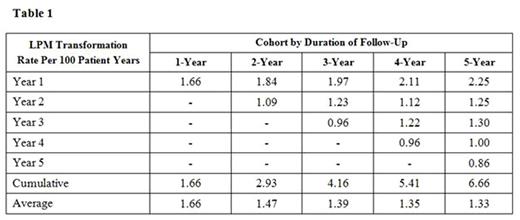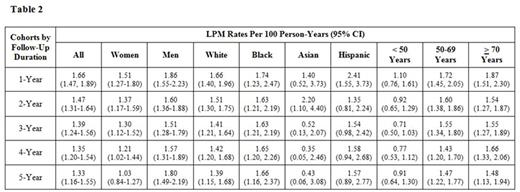Abstract
Background: Prior studies on the risk of progression of monoclonal gammopathy of undetermined significance (MGUS) into lymphoplasmacytic malignancies (LPMs) were almost exclusively in the White populations, comprised of limited number of patients residing in relatively small geographic areas, or included patients mostly detected by serologic screening as part of clinical study (as opposed to detected clinically during evaluation of symptoms suspicious for LPMs). Similar epidemiologic studies in a large, racially diverse population are lacking.
Methods: We conducted a retrospective analysis of incident MGUS patients diagnosed from 2006-2013 using theOptum Labs Data Warehouse, a large database including administrative claims information on >110 million privately insured and Medicare Advantage enrollees throughout the United States. We identified patients with a diagnosis of MGUS (ICD9: 273.1) with 1-5 years of continuous enrollment. Each enrollment cohort based on the duration of follow-up (1-, 2-, 3-, 4-, or 5-year) was analyzed individually to help estimate the progression to cancer. We excluded patients who were diagnosed with LPMs within three months of MGUS diagnosis. We calculated the rate of progression into LPMs (chronic lymphocytic leukemia [CLL], light chain amyloidosis [AL], multiple myeloma [MM], non-Hodgkin lymphoma [NHL], and Waldenström macroglobulinemia [WM]) expressed as number per 100 person-years.
Results: There were 14,728 MGUS patients for a total of 21,288 person-years of follow-up. The distributions of the number of patients and events according to the cohorts classified by duration of follow-up were: 1-year (14,728 patients; 243 events), 2-year (10,644 patients; 307 events), 3-year (7,333 patients; 299 events), 4-year (4,497 patients; 237 events), and 5-year (2,960 patients; 191 events). The rates of progression to LPMs were consistently highest during the first year after MGUS diagnosis (~2.00), generally declined by half during the second year and remained fairly stable thereafter (~1.00; Table 1). The rates of progression into LPMs overall as well as by demographics are shown in Table 2. The risk of progression was significantly higher among men (P < 0.01) and older patients (>50 years; P = 0.03) compared to their counterparts but similar among races (P = 0.15). Of the 243 patients who progressed, the distribution of LPMs was MM (70.0%), NHL (13.2%), WM (12.3%), AL (4.1%), and CLL (0.4%).
Conclusions: Among patients withMGUS, the risk of transformation into LPMs is continuous although twice as high during the first year after MGUS diagnosis compared to subsequent years. The risk of transformation was higher among men and those who were older but did not differ among the racial subgroups. Our findings can be used to develop an optimal risk-based MGUS follow-up strategy that incorporates not only serum biomarkers but also demographic factors.
No relevant conflicts of interest to declare.
Author notes
Asterisk with author names denotes non-ASH members.



This feature is available to Subscribers Only
Sign In or Create an Account Close Modal